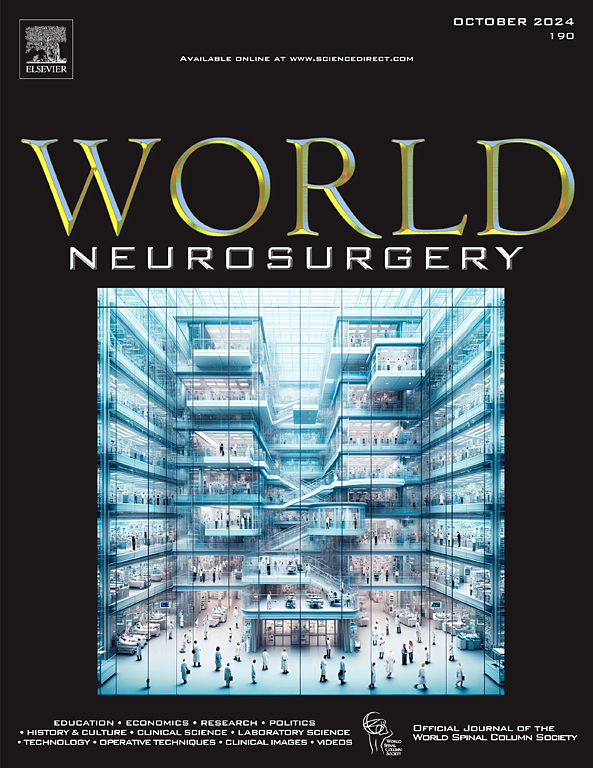预测颅骨成形术后不良预后的因素:一项单中心分析研究
IF 1.9
4区 医学
Q3 CLINICAL NEUROLOGY
引用次数: 0
摘要
目的探讨颅骨成形术(CP)术后不良预后的影响因素。方法采用横断面随访方法,对80例颅脑减压术后行CP的患者进行随访,随访时间为6个月。6个月时的改良Rankin量表≥3定义为预后不良。采用单因素和二元逻辑回归分析探讨预测因素。结果共纳入80例患者;中位年龄为53.5岁,男性48例(60%)。需要DC的主要病理为脑出血(n= 28, 35%)、外伤性脑损伤(n= 27, 33.75%)和恶性中脑梗死(n= 25, 31.25%)。Pre-CP改良Rankin规模在所有患者5,和一个贫穷的结果被认为CP后44(55%)患者。可怜的结果是时代的重要预测因子(优势比(或= 1.96,P = 0.011),二次项age2(或= 0.99,P = 0.011),主要病理需要直流,大脑中动脉梗死(或= 0.03,P = 0.024),占主导地位的叶损伤(或= 48.24,P = 0.001),任何post-DC并发症(或= 61.01,P = 0.025),使用CP自体颅骨瓣以外的材料(或= 10.09,P= 0.035),除美容外的其他CP适应症(OR= 25.86, P= 0.014)。格拉斯哥昏迷评分不能作为预后不良的预测指标(P= 0.586)。结论术前患者特征和手术因素对cp术后恢复均有显著影响。长期功能预后取决于患者的因素,如年龄、损伤性质(例如,优势叶与非优势叶,这可能影响康复潜力)和手术因素,而不是初始神经状态。本文章由计算机程序翻译,如有差异,请以英文原文为准。
Factors Predicting Poor Outcomes Following Cranioplasty: A Single Center Analytical Study
Objective
The study aims to assess the factors predicting poor outcomes after cranioplasty (CP).
Methods
A cross-sectional follow-up study including 80 patients who underwent CP following decompressive craniectomy (DC) and were followed up for six months. Poor outcome was defined as a modified Rankin Scale ≥3 at 6 months. Univariate and binary logistic regression analyses were used to explore the predictors.
Results
Eighty patients were included; the median age was 53.5 years, and 48 were males (60%). The primary pathologies requiring DC were intracerebral hemorrhage (n= 28, 35%), traumatic brain injury (n= 27, 33.75%), and malignant middle cerebral infarction (n= 25, 31.25%). Pre-CP modified Rankin Scale was 5 in all patients, and a poor outcome was seen in 44 (55%) patients after CP. The significant predictors of poor outcome were age (odds ratio [OR= 1.96, P= 0.011), quadratic term age2 (OR= 0.99, P= 0.011), primary pathology requiring DC as middle cerebral artery infarction (OR= 0.03, P= 0.024), dominant lobe injury (OR= 48.24, P= 0.001), presence of any post-DC complications (OR= 61.01, P = 0.025), use of CP material other than autologous skull flap (OR= 10.09, P= 0.035), and indication for CP other than for cosmesis (OR= 25.86, P= 0.014). Presenting Glasgow Coma Scale was not a predictor of poor outcome (P= 0.586)
Conclusions
Both preoperative patient characteristics and procedural factors significantly influence post-CP recovery. Long-term functional outcomes are determined by patient factors like age, nature of injury (e.g., dominant lobe vs. nondominant lobe, which might affect rehabilitation potential), and surgical factors instead of initial neurological status.
求助全文
通过发布文献求助,成功后即可免费获取论文全文。
去求助
来源期刊

World neurosurgery
CLINICAL NEUROLOGY-SURGERY
CiteScore
3.90
自引率
15.00%
发文量
1765
审稿时长
47 days
期刊介绍:
World Neurosurgery has an open access mirror journal World Neurosurgery: X, sharing the same aims and scope, editorial team, submission system and rigorous peer review.
The journal''s mission is to:
-To provide a first-class international forum and a 2-way conduit for dialogue that is relevant to neurosurgeons and providers who care for neurosurgery patients. The categories of the exchanged information include clinical and basic science, as well as global information that provide social, political, educational, economic, cultural or societal insights and knowledge that are of significance and relevance to worldwide neurosurgery patient care.
-To act as a primary intellectual catalyst for the stimulation of creativity, the creation of new knowledge, and the enhancement of quality neurosurgical care worldwide.
-To provide a forum for communication that enriches the lives of all neurosurgeons and their colleagues; and, in so doing, enriches the lives of their patients.
Topics to be addressed in World Neurosurgery include: EDUCATION, ECONOMICS, RESEARCH, POLITICS, HISTORY, CULTURE, CLINICAL SCIENCE, LABORATORY SCIENCE, TECHNOLOGY, OPERATIVE TECHNIQUES, CLINICAL IMAGES, VIDEOS
 求助内容:
求助内容: 应助结果提醒方式:
应助结果提醒方式:


